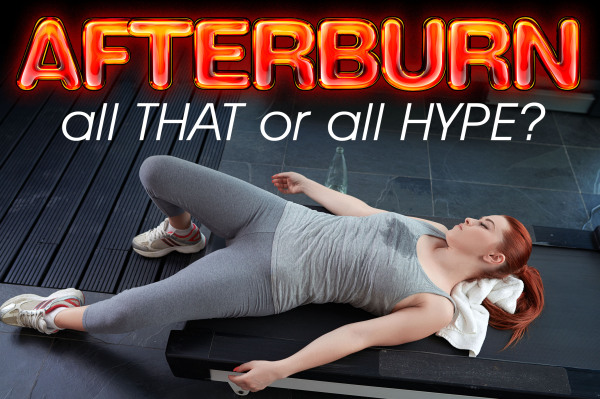
Afterburn: All That or All Hype?

Weight loss ambition is one of the greatest personal drivers of exercise motivation. Therefore, this hot-button is the target of many a fitness marketer. This in and of itself is, in my opinion, is not at all wrong. Inspiration is one of the fundamental tasks of a fitness brand. We have to give people compelling reasons to take new actions to better their health and fitness. However, there persists in fitness marketing some recycled promises and explanations that are at the very least overblown if not intentionally inflated.
One such idea that has received a lot of press and attention in the last couple years is known informally as “afterburn”. More technically this concept is referred to as Excess Post-Exercise Oxygen Consumption or EPOC. Dr. Len Kravits explains that EPOC, “represents the oxygen consumption above resting level that the body is utilizing to return itself to its pre-exercise state.” In other words, EPOC is the extra energy your body spends to restore depleted energy sources and fuel other recovery processes. This is a phenomenon that has been observed by exercise physiologists for decades. Even still, it is often promoted as if some product or program has recently unlocked its secret benefits. Furthermore, there are at least 5 reasons why people shouldn’t let EPOC based claims influence the way they work out.
Don’t let EPOC based claims influence the way you work out
1. EPOC represents a really small number of calories. EPOC energy expenditure from long-duration workouts amounts to about a 7% bonus in calories burned. This means that a workout that burns 500 calories will lead to an extra 35 calories burned above resting levels during recovery from the workout. This is simply not significant. Even if high-intensity work is performed and the EPOC is doubled, we are talking about a “burn” that is not sufficient to rely on as a weight loss strategy. This led researchers to conclude that, “optimism regarding an important role for the EPOC in weight loss is generally unfounded.”
2. Hormones matter much more than calories. The fact that the calories in – calories out view of weight-control is faulty makes EPOC even less relevant. It’s abundantly clear today that exercise is important for lasting weight-control success. However, the most effective approach is to combine resistance training and high-effort conditioning with balanced whole-food nutrition. The point is this, whole-effort exercise (that burns less total calories than traditional workouts) is the most effective approach because this type of work engages the deep muscle fibers which triggers fat-burning hormones to be released and fat-storing hormones to be suppressed. Weight loss isn’t about how many calories you burn. It is about resetting your metabolism.
3. Fat-Burning hormones are released from very brief interval training. The hormonal, and therefore metabolic, benefits of whole-effort conditioning (We call it concentrated cardio at The Exercise Coach) can be realized from startlingly brief bouts when done right. This has been the subject of much research and media attention the past few years. A recent study indicated that one-minute worth of actual interval training work is surprisingly good at resetting fat-burning metabolic mechanisms. The whole workout in the study was only 10-minutes long including rest intervals.
4. Fat Burning hormones are released from quality eccentric loading. Eccentric resistance training is the best way to build strength and muscle. It’s also great for keeping muscle fibers long and healthy. In addition to the power enhancing benefits of eccentric training it can also compound the metabolic effects of exercise. Research shows that high-quality eccentric loading triggers the same fat-burning hormones that interval training does. And, since it’s effectiveness can be leveraged in very brief bouts like interval training it creates the perfect one-two weight loss punch.
5. EPOC focused workouts aren’t for every “body.” The types of workouts touted as EPOC-based are generally 45-60 minutes and made up of very repetitive treadmill and body-weight type exercises. To be sure, an hour of this kind of work will wear you out. However, it’s just more wear and tear than a lot of people can tolerate and the volume of work performed can lead quickly to overtraining, thwarted fat-loss, and demotivation. Better results can be achieved in much less time and when smart interval training and quality strength protocols are used, a great 20-minute workout can change the life of the busiest people – even those with the most beat-up bodies.
